Why you need to know…
What is NFT?
Judging by the number of Google searches, users are increasingly searching for the term NFT. If you belong to the group of those who are familiar with the term or are already part of the community of NFT owners, then this text is not for you.
In that case, we invite you to pass on what you know to your family, friends and colleagues and thereby contribute to the development of the NFT market.
However, if you are in the currently more numerous group that has heard of NFT, but is not quite sure what it is, you are in the right place. Through this text, we will try to clarify a topic that may seem very complicated to you – in a simple way.
For starters…
Why do you even need to know what NFT is and is it a trend that will pass?
Sooner or later, you will come across some NFT. In what form, it depends on the development of the market and the creativity of applying this technology in the future. And the limits are infinite. What is certain is that the market will develop and that each of us will encounter this term sooner or later.
Okay, so what is an NFT?
Non-fungible token.
When I first searched for this term, it was the explanation with which almost every text began. But the fact that it said NFT is a non-fungible token didn’t help me much, and it probably won’t help you either. In order to understand what non-fungible is, I had to first understand what fungible is.
When we say things are fungible, it means that they can be easily replaced. Let’s say securities, goods, foreign currency, coins… Specifically, you can exchange one 100 dinar banknote for another 100 dinar banknote, it doesn’t matter which one you have because they are of the same value. But if one banknote was signed by Ronaldo, then you certainly won’t want to exchange it for another 100 dinars, because it has become unique and its value is much higher – it has become non-fungible or irreplaceable (unique, has no fixed price, you can determine it yourself how much money would you exchange it for).
Now we come to the disentanglement of the NFT term itself. NFT is a non fungible or irreplaceable, unique token. Technically, it is a file on the blockchain that is unique and linked on the one hand to the crypto wallet of the one who owns it, and on the other hand to some (so far most common) digital asset. It is practically a proof of possession of the digital asset.
That digital asset can be a photo, animation, musical piece, text, image… At the last conference on the topic of Web3 that Homepagers visited, on one of the panels was a controversy about whether everything including physical objects, should be tokenized, so we will follow that in one of the following texts.
But for now, it’s enough to understand that NFT authenticates and owns a digital asset, and that from a technical point of view, it’s data files on the blockchain, and the part that’s visible is some form of digital asset.
To help you to understand, here is an example of an NFT:
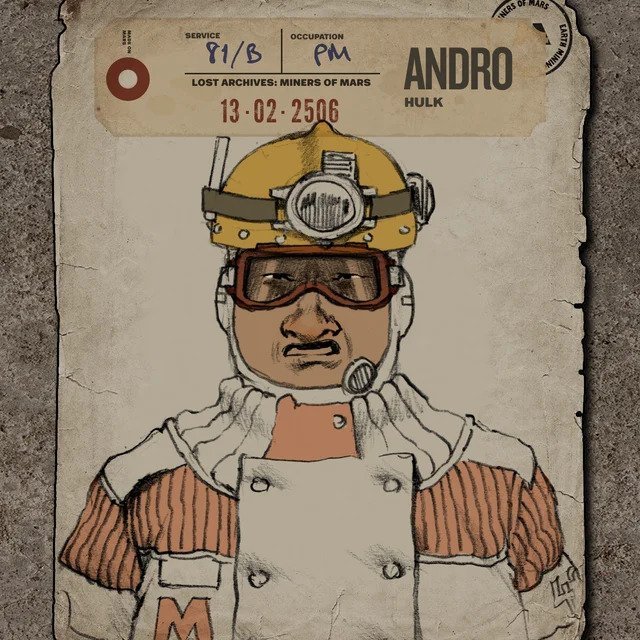 Ilustration No1 – Miners of Mars – Andro
Ilustration No1 – Miners of Mars – Andro
This NFT belongs to the Miners of Mars collection and I consciously didn’t took an example of one of the world’s most successful collections, but a collection of domestic authors as a very realistic example of an NFT project.
So we see a thumbnail of a miner from the Miners of Mars collection that someone bought and is now reselling on the market. If you logically think that you can save and copy this same image, you are very right. You can also copy Van Gogh’s Sunflowers:
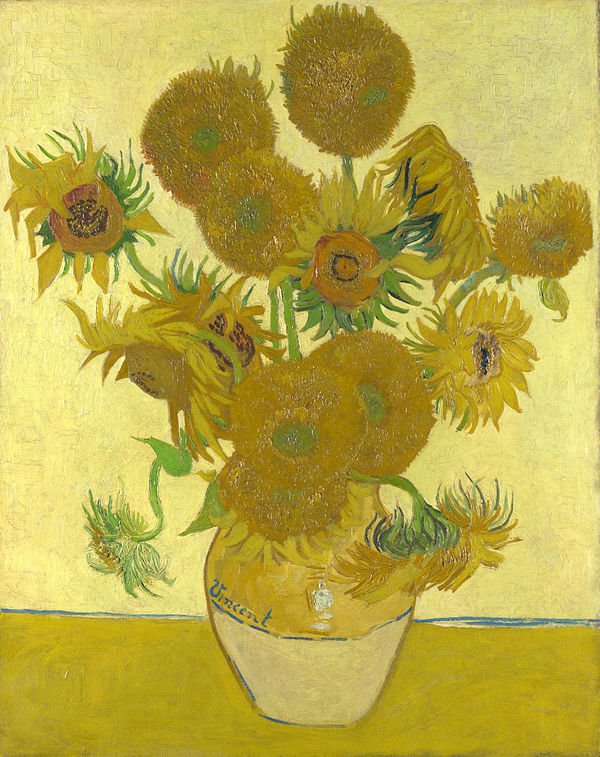 Ilustration No2 – Sunflowers, Van Gogh
Ilustration No2 – Sunflowers, Van Gogh
What you will lack in both cases is proof of authenticity and ownership. In the case of NFT, it is that file on the blockchain that confirms who the owner is, and since the blockchain is very transparent, you can also see all the previous owners and the prices at which that NFT was sold.
Specifically, you can have a picture of someone’s NFT, but that doesn’t mean you own that NFT. Just like you can have a copy or photograph of a Sunflowers, but you don’t own the original image. So NFT is not just a thumbnail. The thumbnail is what you see in this case, and the NFT is the file on the blockchain that verifies that you are the owner of that thumbnail. An NFT is only tied to your crypto wallet, you own it, you further determine its price and you can further sell it.
NFT is very often part of a collection. Each collection has its own theme or purpose. In the case of the example I gave, the topic is miners from Mars. Miners of Mars is a collection of 7,000 unique, hand-drawn characters minted as NFTs.
Minting is a term you’ll hear a lot. When someone has mined an NFT, it means that they have published it on the blockchain and that from that moment its purchase is possible.
Where to buy NFT?
There are many platforms for NFT trading. The largest are OpenSea and Magic Eden. We will talk about them in more detail in one of the following texts, and here is how the Miners of Mars collection looks on the Magic Eden platform:
 Ilustration No3 – Miners of Mars, Magic Eden
Ilustration No3 – Miners of Mars, Magic Eden
There all the miners from the collection are available for purchase, and by clicking on individual miners, you will see all the details related to that NFT.
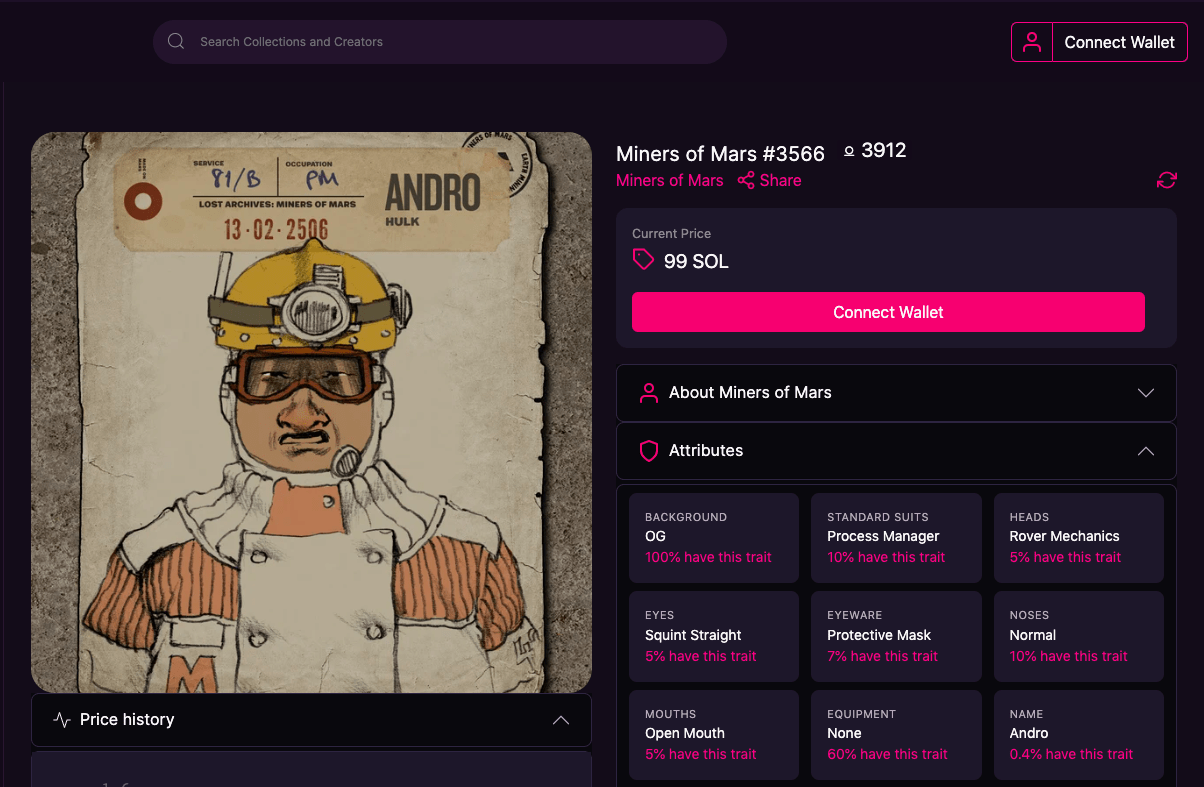 Ilustration No4 – Andro the Miner of Mars, Magic Eden
Ilustration No4 – Andro the Miner of Mars, Magic Eden
Like the products in the online shop we are used to, our Andro the miner on the Magic Eden platform has a picture, price, features…
The first thing that catches the eye is that if we want to buy this NFT, we have to connect the wallet to the platform (see the connect wallet button). Specifically, this means that before buying NFTs, you must have your own crypto wallet. It’s actually a program, software or system/device that allows you to store and transfer NFTs (and cryptocurrencies, tokens) as in a regular wallet.
One person can have several wallets, while there are many wallets on offer. Most often, a software wallet like MetaMask is opened, but there are also hardware wallets (Ledgers) that look like a USB.
Each wallet has two keys, one that is public and serves as a transfer address, while the other is a private key and for security reasons only you or someone you want to give access to your crypto assets have.
The most common practice is to open multiple wallets for security reasons, so that the software wallets are used for trading and the hardware wallets for storage.
But before choosing a wallet and opening it, be sure to research this topic in more detail because it is very sensitive. Unlike other situations when you lose passwords and such and you can contact a service for support and help – here in the web 3 you are alone and take all responsibility. It can also happen that you lose something irretrievably if you forgot your wallet password, transferred it to the wrong person, etc.
In short, the process of buying and selling NFTs would go like this:
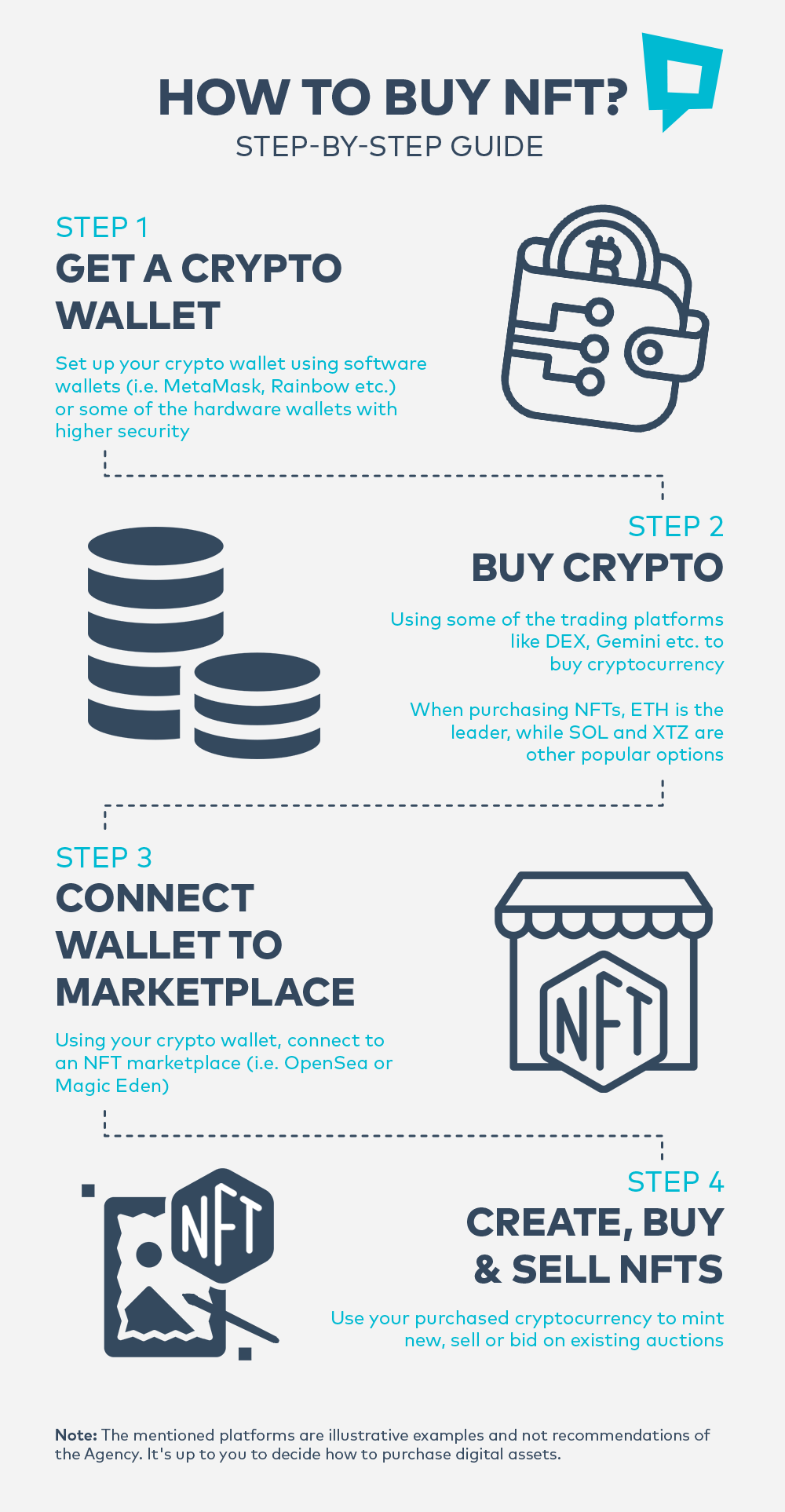
OK, why should I give money for NFT?
In part, the answers are already visible through the text. NFT can have sentimental, artistic or utility value. You can be a fan of an artist and buy his works, you can be a collector of NFTs, but NFTs can also have some use value which is a very certain future of NFTs. You can also trade them which has been quite current for a while. If you are a beginner in everything, you should not rush into trading, but first familiarize yourself with the industry and the market itself, arm yourself with knowledge, and only then invest.
Don’t fall for texts that send the message that trading NFTs guarantees a profit. You can make money by trading shares, securities, and many other ways, but only when you know what you are doing and have enough knowledge and experience. It’s the same here. While there is no doubt that the NFT market has potential, every investment carries risk.
It is natural that you will see many stories and examples of someone making money through NFT, because realistically, hardly anyone will write about their losses and bad investments. And on the NFT market there are as many as there are.
Additionally – someone can buy an NFT for $500 and value it at $50,000. Just because you see someone owning a valuable NFT doesn’t mean they’ve made money on it until they sell it, until the market confirms it and the buyer recognizes that value and pays that price.
But back to the reasons for buying NFT. Besides trading, the reasons to buy NFTs can be various.
We mentioned collecting and artistic value and that’s where it all started.As before, someone buys works of art and invests fabulous sums in them, just to own them. Collectors have been doing this until now, while there have always been those who trade art for profit.
There are also works such as the Mother of creation triptych by Madonna and Beeple (a digital artist who sold one of his NFTs for an incredible $69 million). Mother of creation consists of three NFTs, video animations and the entire profit from the sale go to charity.
However, where the future of NFTs lies is the utility value. This opens up an unlimited number of possibilities that we will see in the coming period.
For example, NFT can provide owners with some kind of exclusivity – attendance at events only for NFT owners, access to part of the content or online shop and offers that are not available to everyone, and such…
Here is a domestic example – EXIT festival had NFTs this year. Depending on which NFT you buy, you have different benefits:
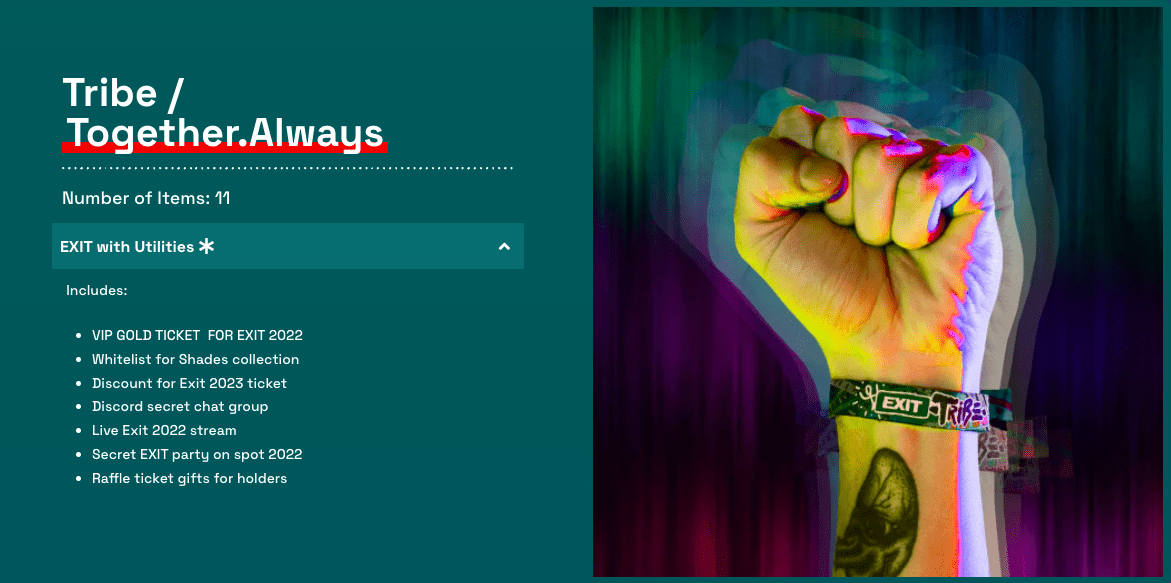 Illustration No. 6 – NFT Tribe, EXIT festival
Illustration No. 6 – NFT Tribe, EXIT festival
Owners of this NFT have all the listed benefits, including a secret EXIT party.
In the future, we are aiming for our data to be tokenized, to be entered on the blockchain. This would mean much greater security of that data and preventing its modification and manipulation. At the same time, we ourselves would be the owners of that data and decide to whom we grant and revoke access to the data. Let’s say health information, examinations, medical history and therapy… imagine having it all in one place and being able to access it no matter where you are in the world. That would mean a lot to the doctor you visited for an examination, say, on vacation. He would have a much clearer picture of your condition and history, and you would receive more reliable therapy and treatment.
What we will certainly see in the future are NFT tickets for events and matches, NFT music albums, NFT as an access card to certain communities and associations, NFT in the gaming industry and metaverse, in the fashion industry, but also in the real estate market. We have seen from the example project done by Madonna and Beeple that NFT can be used to collect donations. There are also already NFTs which are a kind of discount coupons for products and services, NFT service packages etc.
All in all, we are in for a wonderful period of development of technology and the NFT market. It’s up to you to enjoy riding that roller coaster, or to be a bystander. Homepagers are riding a wave of adrenaline caused by everything that is new and digital 🚀
As we have done for the past 10 years, we are dedicated to educate the market and to help brands and companies to catch up with digital. Get in touch and we will be happy to talk with you about the NFT market and the huge potential it offers.
Illustration are from Miners of Mars, Wikipedia, Magic Eden, nftnow.com, nft.exitfest.org
Author: Milka Negrovic


